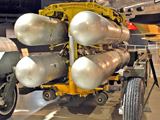Deterrence at the Operational Level of War
25 Sep 2012
By James Blackwell for Air Force Research Institute (AFRI)
Let us not make the world safe for conventional war.
—Michael Quinlan, Thinking About Nuclear Weapons
Deterrence was a strategy of the Cold War. It guided the development of strategic concepts even when nonnuclear operations were the predominant concern of the US military, including conventional warfare in Korea and Europe and counterinsurgency in Southeast Asia.
Today our understanding of deterrence has atrophied. In fact, deterrence has been incarcerated into one of two holding cells, as if it were some kind of contagion that requires quarantine. For all operations that might involve employment of nuclear weapons, campaign planning has become the exclusive jurisdiction of US Strategic Command (STRATCOM). Even there, deterrence is but one of six missions. For the geographic combatant commands, deterrence is confined to one phase of a joint campaign, one that is most often more hope than plan. Phase 2 of the joint campaign, “Deterrence,” has in fact become mostly all about moving forces into the theater for the purpose of seizing the initiative or mounting a defense rather than deterring the conflict from happening altogether.
This conceptual decline occurred for no apparent reasons. In the 1990s, many became convinced that our conventional combat power was so superior we did not need nuclear weapons to deter—conventional capabilities would be sufficient. Then in the beginning of the twenty-first century we became—rightly—focused on winning the war against violent extremists and conducting counterinsurgency campaigns.
In so many ways we now have deterrence all wrong—especially during campaign planning. For example, in the Joint Capabilities Integration and Development System (JCIDS) we combine deterrence capabilities with the force application joint capability area. As a result, platforms such as intercontinental ballistic missiles (ICBM), sea-launched ballistic missiles (SLBM), reentry vehicles and associated warheads, warhead arming, fusing and firing mechanisms, and long-range bombers—systems we hope never to use in nuclear combat—have to compete for resources with fighter aircraft, attack submarines, and MRAPs (mine resistant ambush protected vehicles) on the basis of military utility. This is a competition in which nuclear capabilities will never prove to be cost-effective to those who would rather fight than deter.
It is time now to reinvent deterrence for the operational level of war in the twenty-first century. Deterrence is still about creating fear of consequences, but we have to apply military power to a vastly different world than the one in which the concept was created. Focusing on the concept of deterrence and its complexity is instructive at the operational level of war. Campaign planners should reconsider some fresh axioms for integrating deterrence.

